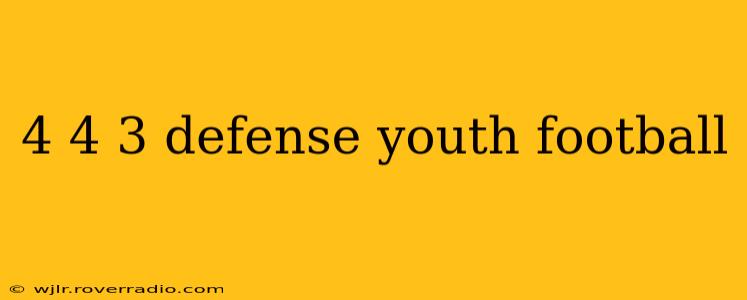The 4-4-3 defense is a versatile and effective strategy for youth football teams. Its balanced approach allows coaches to adapt to various offensive formations while teaching fundamental defensive techniques. This guide dives deep into the 4-4-3, addressing common questions and providing valuable insights for coaches and players alike.
What are the Roles of Each Player in a 4-4-3 Defense?
The 4-4-3 defense consists of four defensive linemen, four linebackers, and three defensive backs. Each player has a crucial role:
-
Defensive Linemen (4): Two defensive tackles and two defensive ends. Their primary responsibilities are to penetrate the offensive line, disrupt the running game, and put pressure on the quarterback. Youth players should focus on proper tackling technique and reading the offensive line's blocking schemes.
-
Linebackers (4): These players are the heart of the defense. They cover short to intermediate passes, defend against running plays, and blitz the quarterback. Youth linebackers need to master gap assignments, reading offensive formations, and reacting quickly to the play.
-
Defensive Backs (3): Two cornerbacks and one safety. Cornerbacks cover wide receivers, while the safety provides support in the secondary, assisting in pass coverage and run support. Youth players in the secondary must focus on proper coverage techniques, reading the quarterback's eyes, and making tackles in open space.
How Does the 4-4-3 Defense Work Against the Run?
The effectiveness of the 4-4-3 against the run hinges on gap control and disciplined tackling. The defensive line aims to penetrate the offensive line, clogging running lanes and forcing the ball carrier to the outside. The linebackers read the offensive line's blocking schemes to fill gaps and make tackles. The defensive backs provide support against outside runs, ensuring no gaps are left for the ball carrier. Proper tackling is paramount; youth players should focus on form tackling to minimize injuries and maximize efficiency.
How Does the 4-4-3 Defense Work Against the Pass?
The 4-4-3's pass defense relies on both zone and man coverage. The cornerbacks primarily focus on man-to-man coverage of the wide receivers, while the safeties provide zone coverage, patrolling deep zones and assisting with run support. The linebackers are responsible for covering short to intermediate routes, often utilizing zone coverage techniques. Youth players need to be taught proper footwork, hand placement, and the importance of reading the quarterback's eyes in pass coverage.
What are the Strengths and Weaknesses of the 4-4-3 Defense?
Strengths:
- Versatility: Adaptable to various offensive formations.
- Balanced Approach: Strong against both the run and the pass.
- Solid Run Defense: Effective at clogging running lanes and limiting rushing yards.
Weaknesses:
- Vulnerable to Spread Formations: Can be exposed to quick passes and screens in spread offenses.
- Requires Disciplined Players: Effective only with well-coached, disciplined players who understand their assignments.
- Potential for Mismatches: Speed mismatches on the outside can be exploited by quick receivers.
What are Some Drills to Teach the 4-4-3 Defense?
Effective coaching is crucial for the success of the 4-4-3. Drills should focus on:
- Gap Assignments: Drills reinforcing proper gap responsibilities for each player.
- Tackling Technique: Drills emphasizing proper form tackling to minimize injuries and maximize effectiveness.
- Pass Coverage Drills: Drills focusing on proper footwork, hand placement, and reading the quarterback's eyes.
- Blitz Packages: Drills incorporating blitz packages to create pressure on the quarterback.
How Can I Adjust the 4-4-3 Defense for Different Offensive Formations?
The beauty of the 4-4-3 lies in its adaptability. Coaches can adjust the defense based on the opponent's offensive formation. For example:
- Against Spread Formations: Adjusting linebackers to cover more space and incorporating more zone coverage in the secondary.
- Against Power Running Formations: Focusing on gap control and emphasizing aggressive tackling by the defensive line and linebackers.
By understanding the fundamental roles, strengths, weaknesses, and drills associated with the 4-4-3 defense, youth football coaches can effectively implement this versatile strategy and develop well-rounded defensive players. Remember to emphasize fundamentals, proper technique, and teamwork to build a strong and successful defense.
